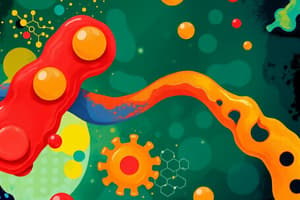Podcast
Questions and Answers
Which characteristic is true of fatty acid tails?
Which characteristic is true of fatty acid tails?
- They contain many polar groups.
- They are hydrophilic.
- They are long hydrocarbon chains with hydrophobic properties. (correct)
- They are short hydrocarbon chains.
A fatty acid with multiple double bonds is classified as:
A fatty acid with multiple double bonds is classified as:
- Trans-unsaturated.
- Polyunsaturated. (correct)
- Saturated.
- Monounsaturated.
What type of lipid has a polar phosphate head group and nonpolar fatty acid tails?
What type of lipid has a polar phosphate head group and nonpolar fatty acid tails?
- Triglyceride.
- Phospholipid. (correct)
- Wax.
- Glycolipid.
Which factor does NOT directly affect membrane fluidity?
Which factor does NOT directly affect membrane fluidity?
What is the main function of high density lipoproteins (HDLs)?
What is the main function of high density lipoproteins (HDLs)?
Which class of lipids is primarily used as hydrophobic coatings?
Which class of lipids is primarily used as hydrophobic coatings?
What type of bond connects two monosaccharides to form a disaccharide?
What type of bond connects two monosaccharides to form a disaccharide?
Which type of lipids are involved in signal transduction, structural support, and cell recognition?
Which type of lipids are involved in signal transduction, structural support, and cell recognition?
What defines an element?
What defines an element?
Which of these best describes a polymer?
Which of these best describes a polymer?
What is the primary difference between ribose and deoxyribose sugars?
What is the primary difference between ribose and deoxyribose sugars?
What type of reaction is responsible for the formation of phosphodiester bonds between nucleotides?
What type of reaction is responsible for the formation of phosphodiester bonds between nucleotides?
Which of the following is true about intermolecular forces?
Which of the following is true about intermolecular forces?
Which of these statements accurately describes the purpose of tRNA?
Which of these statements accurately describes the purpose of tRNA?
Given the formula for monosaccharides $(CH_2O)_n$, how many carbon atoms are present in a monosaccharide with n=5?
Given the formula for monosaccharides $(CH_2O)_n$, how many carbon atoms are present in a monosaccharide with n=5?
What process is used to break down polymers into individual monomers using water?
What process is used to break down polymers into individual monomers using water?
What type of bonds primarily hold together starch and glycogen polysaccharides?
What type of bonds primarily hold together starch and glycogen polysaccharides?
Which protein structure is characterized by the specific sequence of amino acids?
Which protein structure is characterized by the specific sequence of amino acids?
What is the role of peptide bonds in proteins?
What is the role of peptide bonds in proteins?
Which statement is correct regarding the role of a catalyst in a chemical reaction?
Which statement is correct regarding the role of a catalyst in a chemical reaction?
Which polysaccharide serves as a structural component in plant cells?
Which polysaccharide serves as a structural component in plant cells?
What is a key characteristic of an enzyme's active site?
What is a key characteristic of an enzyme's active site?
What happens to a protein when it denatures?
What happens to a protein when it denatures?
Which of these best describes a holoenzyme?
Which of these best describes a holoenzyme?
What is primarily accomplished by a phosphatase enzyme?
What is primarily accomplished by a phosphatase enzyme?
How does a negative feedback loop affect enzyme activity?
How does a negative feedback loop affect enzyme activity?
In competitive inhibition, what happens when an inhibitor binds to the enzyme?
In competitive inhibition, what happens when an inhibitor binds to the enzyme?
If a reaction is subject to noncompetitive inhibition, how do $K_M$ and $V_{max}$ change?
If a reaction is subject to noncompetitive inhibition, how do $K_M$ and $V_{max}$ change?
What effect does competitive inhibition have on $K_M$ and $V_{max}$ of an enzymatic reaction?
What effect does competitive inhibition have on $K_M$ and $V_{max}$ of an enzymatic reaction?
Flashcards
Enzymes
Enzymes
Biological catalysts that speed up reactions without being consumed.
Active Site
Active Site
The specific region on an enzyme where the substrate binds.
Ribozyme
Ribozyme
A type of enzyme that is made of RNA instead of protein.
Cofactors
Cofactors
Signup and view all the flashcards
Holoenzyme
Holoenzyme
Signup and view all the flashcards
Apoenzyme
Apoenzyme
Signup and view all the flashcards
Inhibitor
Inhibitor
Signup and view all the flashcards
Vmax
Vmax
Signup and view all the flashcards
What are polysaccharides?
What are polysaccharides?
Signup and view all the flashcards
What is starch?
What is starch?
Signup and view all the flashcards
What is glycogen?
What is glycogen?
Signup and view all the flashcards
What is cellulose?
What is cellulose?
Signup and view all the flashcards
What are amino acids?
What are amino acids?
Signup and view all the flashcards
What is an atom?
What is an atom?
Signup and view all the flashcards
What is a molecule?
What is a molecule?
Signup and view all the flashcards
What are intramolecular forces?
What are intramolecular forces?
Signup and view all the flashcards
What are intermolecular forces?
What are intermolecular forces?
Signup and view all the flashcards
What is a monomer?
What is a monomer?
Signup and view all the flashcards
What is polymerization?
What is polymerization?
Signup and view all the flashcards
What is a polymer?
What is a polymer?
Signup and view all the flashcards
What is a dehydration reaction?
What is a dehydration reaction?
Signup and view all the flashcards
Fatty Acid
Fatty Acid
Signup and view all the flashcards
Unsaturated Fatty Acid
Unsaturated Fatty Acid
Signup and view all the flashcards
Saturated Fatty Acid
Saturated Fatty Acid
Signup and view all the flashcards
Triglyceride
Triglyceride
Signup and view all the flashcards
Phospholipid
Phospholipid
Signup and view all the flashcards
Membrane Fluidity
Membrane Fluidity
Signup and view all the flashcards
Cholesterol
Cholesterol
Signup and view all the flashcards
Lipoprotein
Lipoprotein
Signup and view all the flashcards
Study Notes
Enzymes
- Catalysts increase reaction rates without affecting equilibrium, reaction direction, or spontaneity.
- Enzymes are biological catalysts, mostly proteins.
- Enzymes have active sites that bind specific substrates to increase reaction rate.
- Active sites exhibit "induced fit," slightly changing shape to accommodate the substrate.
- Ribozymes are non-protein enzymes made of RNA.
- Cofactors are molecules that enhance enzyme function.
- Holoenzymes are enzymes with their cofactors bound.
- Apoenzymes are enzymes without their cofactors.
- Enzymes can catalyze reactions through substrate approach, presence of acids/bases, and electrostatic interactions.
- Phosphatases remove phosphate groups from substrates.
- Phosphorylases add phosphates to substrates via bond breakage.
- Kinases transfer phosphates from ATP to a substrate.
Enzyme Inhibition and Kinetics
- Enzyme activity alteration impacts reaction rates.
- Substrate binding to active or allosteric sites impacts manipulation.
- Positive feedback loops increase reaction.
- Negative feedback loops decrease reaction.
- Molecules bind to allosteric sites influencing enzyme function.
- Competitive inhibitors compete with substrates for the active site.
- Noncompetitive inhibitors bind to allosteric site, altering active site conformation.
- Enzyme kinetics tracks reaction velocities against substrate concentration.
- Vmax is the maximum reaction velocity.
- Km is substrate concentration at half Vmax.
- Competitive inhibition increases Km, preserving Vmax.
- Non-competitive inhibition decreases Vmax, preserving Km.
Lipids
- Lipids primarily consist of carbon, hydrogen, and oxygen.
- Fatty acid tails are hydrophobic hydrocarbon chains.
- Lipids can be hydrophobic, hydrophilic, or amphipathic.
- Saturated fatty acids lack double bonds, whereas unsaturated fatty acids have one or more double bonds.
- Monounsaturated fatty acids have one double bond, while polyunsaturated fatty acids have multiple double bonds.
- Cis and trans configurations affect lipid packing.
- Glycerol backbones hold fatty acids in triglycerides.
- Triglycerides are mostly hydrophobic.
- Phospholipids are amphipathic, with a polar head and nonpolar tails.
- Phospholipids form bilayers in aqueous solutions.
Lipid Subtypes
- Membrane fluidity depends on temperature, cholesterol, and fatty acid unsaturation.
- Cholesterol is a crucial component in steroid hormones, vitamin D, and bile acids.
- Lipoproteins transport cholesterol and proteins in the blood.
- Low-density lipoproteins deposit cholesterol in tissues.
- High-density lipoproteins deliver cholesterol to the liver.
- Waxes are simple hydrophobic protective coatings.
- Carotenoids are long-chain lipids found in pigments.
- Sphingolipids support cell signaling, structure, and recognition.
- Glycolipids are fatty acids attached to carbohydrates, crucial for cell membranes.
Biological Chemistry
- Matter occupies space and possesses mass.
- Elements are pure substances with unique chemical and physical properties.
- Atoms are the fundamental units of matter.
- Molecules are formed when two or more atoms bind.
- Intramolecular forces bond atoms within a molecule.
- Intermolecular forces bond molecules together.
- Monomers are single molecules that combine to form polymers.
- Polymerization bonds monomers into polymers.
- Dehydration (condensation) reactions link monomers, releasing water.
- Depolymerization breaks polymers into monomers.
- Hydrolysis uses water to break polymer bonds.
Nucleic Acids
- Nucleic acids (DNA and RNA) are built from nucleotides.
- Nucleotides consist of a sugar, a nitrogenous base, and phosphate groups.
- RNA molecules are typically single-stranded.
- Ribose sugar is the component of RNA.
- DNA molecules are typically double-stranded.
- Deoxyribose sugar is the component of DNA
- Phosphodiester bonds connect nucleotides together in a chain.
- The backbone of nucleic acids is formed by sugars and phosphates.
- Nucleotides join to create a nucleic acid chain.
- mRNA carries genetic information for protein synthesis.
- tRNA transfers amino acids during protein synthesis.
- rRNA is a component of ribosomes, sites of protein synthesis.
- miRNA and dsRNA regulate gene expression.
Carbohydrates
- Carbohydrates are used for energy and structural support.
- Carbohydrates contain carbon, hydrogen, and oxygen atoms.
- Monosaccharides are simple carbohydrates (e.g., ribose, fructose, glucose).
- Disaccharides are formed by linking two monosaccharides through glycosidic bonds.
- Polysaccharides are complex carbohydrates with many monosaccharides linked through glycosidic bonds.
- Starch is a plant-based storage polysaccharide.
- Glycogen is an animal-based storage polysaccharide.
- Cellulose is a structural polysaccharide found in plant cell walls.
Protein Structure
- Proteins are composed of amino acids linked by peptide bonds.
- There are 20 different amino acids in proteins.
- Primary structure is the linear sequence of amino acids.
- Secondary structure involves local folding patterns (alpha-helices, beta-sheets).
- Tertiary structure is the three-dimensional shape of a single polypeptide chain.
- Quaternary structure involves the arrangement of multiple polypeptide chains to form a protein complex.
- Protein denaturation disrupts higher-level structure, affecting function.
- Proteins have diverse functions (e.g., enzymes, hormones, structural components).
Studying That Suits You
Use AI to generate personalized quizzes and flashcards to suit your learning preferences.




